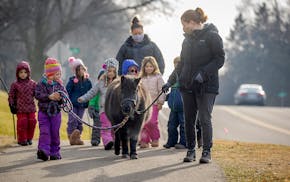Apartments, condos and assisted-living facilities dominate the small city of Lilydale, along the bluffs of the Mississippi River in Dakota County.
"We've kind of always attracted older people, people that are nearing retirement," City Administrator Mary Tollefson said.
But even city leaders can't help but notice the influx of older adults: The majority of Lilydale residents are 65 or older.
Lilydale offers an extreme example of a demographic shift happening across Minnesota and the nation as baby boomers age and their needs change, prompting cities to rethink their services.
"Statewide, the older adult population is aging very rapidly between 2010 and 2030," said Minnesota State Demographer Susan Brower. "But different communities age at different rates."
A Minnesota Star Tribune analysis of data from the Metropolitan Council and U.S. Census Bureau shows that some Twin Cities suburbs are seeing a larger surge in senior citizens than others. The urban core and innermost suburbs haven't aged as much over the past 30 years as many second-ring, farther-flung suburbs have.
In Lilydale, nearly 7 out of every 10 residents are 65 or older. In Minnetonka, almost 1 in 4 residents are seniors. And, even in Apple Valley, a city that is growing overall, older adults make up a growing segment of the population.
"We called it the 'silver tsunami' at one point," said Julie Wischnack, community development director in Minnetonka. "We knew this was going to happen."
Apple Valley
Apple Valley experienced an uptick in development after the city incorporated in 1969, fueled in part by a movement that saw families flocking to suburbs. A significant number of those earliest residents remain in the city.
"They have known only one town: Apple Valley," said Community Development Director Tim Benetti. "They were born or grew up here. They went to college, did their armed services, and just came back to Apple Valley."
So as city leaders planned in recent years for a continuing population boom — Apple Valley is now home to more than 55,000 people — Benetti kept hearing the same piece of advice: "Your population is aging, so be prepared for that."
Todd Graham, principal forecaster for the Met Council, has been telling city leaders: "It's not just you."
"The aging trend and people living longer is the big dynamic right now. You'll see more places appearing to have larger senior populations," Graham said.
To meet the changing needs, Apple Valley leaders have been approving new senior housing or expanding existing facilities. They've been supporting a new bus service that aims to help older adults get around the city for doctor's appointments or other needs.
Minnetonka
In Minnetonka, where home values tend to run above the metro average, many seniors have also chosen to age in place.
"I think that people like their homes in Minnetonka. They want to hang on to them," said Wischnack, the community development director. For others, the prices of new construction may be "just too much."
The result is that the percentage of senior citizens in Minnetonka has more than doubled over the past 30 years, and 23% of residents are now 65 or older.
Like their peers in other suburban cities, Minnetonka leaders have approved new housing projects catering to seniors. They've tried to streamline the process for people who need accommodations, such as the ability to build a ramp at their home, and they try to share information about programs offering help with maintenance.
But with people living longer on average, city officials have also tried to take a broad approach to senior programming, offering events that cater to people who are active and people who need assistance. Senior Services offers dementia support groups, senior mingle events and athletic events.
"It's not like the seniors are sitting still," Wischnack said. "They're having bike clubs, and they're doing golf leagues and there's even a 70-plus slow-pitch softball [league]."
Lilydale
It doesn't take much to change the dynamics of a city as small as Lilydale, where the population currently hovers between 800 and 900 people. Its compact location, along a bluff, has long attracted multifamily housing.
Tollefson, the city administrator, suspects that's part of the reason it has also long attracted older adults. In 1990, just over one-third of Lilydale residents were 65 or older, according to census data.
But, like other cities across the metro region, Lilydale also received new proposals for senior-specific housing as construction bounced back in the aftermath of the Great Recession.
"Senior, age-restricted housing or senior facilities are showing up pretty much all over the development market," said Graham, with the Met Council. "This is a growing market segment."
Lilydale leaders approved permits for two age-restricted facilities in the past 15 years that together brought in more than 150 new units of housing. The percentage of older adults grew dramatically, rising to 68%.
Lilydale leaders continue to approve proposals for new, multifamily housing projects. But more recent projects haven't come with age restrictions.
Tollefson said, "We just felt like we needed to be open to bringing in a younger generation."
MaryJo Webster of the Minnesota Star Tribune contributed to this story.
Supreme Court allows DOGE team to access Social Security systems with data on millions of Americans

Thompson found guilty of murder in car crash that killed 5 young women

University of Minnesota is putting its golf course up for sale
Feeding Our Future probe: Apple Valley woman charged with defrauding food program of $1.4 million

